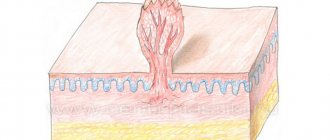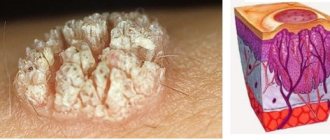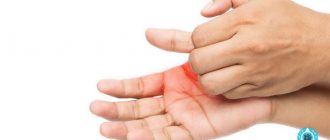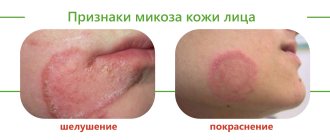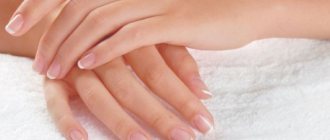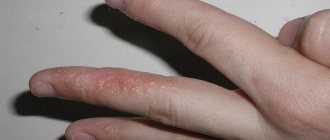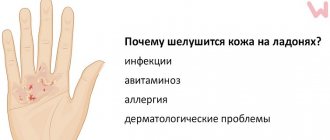A wart on the toe can cause pain and discomfort when walking or playing sports. The cause of the pathology is human papillomavirus infection. Every 4th adult experiences warts, but not all cases require removal of the formations. To determine treatment tactics, you need to consult a dermatologist; further treatment can be carried out at home.
Warts that occur on the toes do not always need to be removed
Reasons for appearance
Warts are benign skin growths. Skin growths can occur anywhere on the body, but most often on the face, fingers, soles and toes, and genitals. They are caused by a viral infection, the human papillomavirus (HPV). There are more than 100 types of HPV, each of which has its own characteristics.
You can become infected with human papillomavirus infection in a bathhouse, sauna, swimming pool and other public places when walking barefoot. The virus remains on surfaces for several months, increasing the likelihood of infection. Symptoms of the disease do not appear immediately; it usually takes 1 month from the moment of infection to the first manifestations.
The following factors increase the likelihood of infection:
- microtraumas, abrasions, cuts on the plantar side of the fingers;
- increased sweating of the feet;
- wearing uncomfortable shoes;
- dry skin, cracks.
The thing is that it is easier for viruses to get into steamed and injured skin. The occurrence of the disease is also influenced by general diseases - diabetes and other endocrine pathologies, flat feet, arthrosis and arthritis, dermatological diseases.
Pathohistology
Rice.
6. Simple wart. Microscopic picture: excessive keratinization of the outer parts of the epidermis (yellow), proliferation of the basal parts of the epidermis in the form of papillae (green). Van Gieson staining. Pathohistology - thickening of the layers of the epidermis, hyperkeratosis, severe acanthosis, accompanied by a strong development of the papillary layer of the dermis (color. Fig. 6). Infected cells contain inclusions containing large amounts of deoxyribonucleic acid. In the epithelial layer of some warts. They found raspberry and rose hip thorns and asbestos crystals (“asbestos warts”), which may have been the source of a viral infection.
Wart on the big toe: how it manifests itself
The main symptom of the disease is the presence of a formation on any toe (little toe, big toe) or in the space between the toes. The build-up appears mainly in places of greatest pressure and friction. What does a subcutaneous wart look like (pictured):
- the size varies from 1 mm to 1-2 cm or more, when there are several formations and they merge;
- the surface is rough, dense;
- the shape can be different: from oval to irregular;
- whitish color;
- small black dots may appear on the surface, which are thrombosed capillaries;
- absence of relief lines in the affected area;
- the contours are clear.
Warts on the toes cause a lot of inconvenience, interfere with walking, and often cause pain. Over time, the growth becomes denser, which only intensifies the symptoms.
Diagnosis
The diagnosis in most cases is not difficult, but in some cases warts have to be differentiated from diseases that have similar clinical manifestations on the skin.
In such cases, the differential diagnosis is based on the clinical and morphological characteristics of individual forms (table). Clinical and morphological characteristics and differential diagnosis of warts and diseases similar in clinical picture
| Name | Preferential localization | Clinical picture | Histological changes |
| Common wart | Back of hands, fingers, face, scalp | Round, dense, gray-yellow nodules raised above the skin with a rough surface | Hyperkeratosis, in places with parakeratosis, acanthosis in the form of massive outgrowths converging towards the center of the bladder, papillomatosis. In the spinous and granular layers there are large vacuolated cells containing DNA inclusions |
| The wart is flat | Face, back of hands | Small, flattened papules, normal skin color or yellowish-brown, round or polygonal, barely protruding above the skin level, usually having a smooth surface | Hyperkeratosis without parakeratosis, acanthosis, granulosis; no papillomatosis. In the horny, granular, spinous layers there is pronounced vacuolization of cells, which are often significantly increased in size, with signs of pyknosis. The stratum corneum has the appearance of a so-called wicker basket |
| Plantar wart | Plantar surface of feet | Callus-like dense formations of bundles of filiform papillae, in the center covered or surrounded by a roller of powerful horny layers, painful | The same as with B. vulgaris, but hyperkeratosis and parakeratosis, as well as vacuolization of cells, are more pronounced |
| Acute wart (condyloma acuminata) | External genitalia, inguinal-femoral, intergluteal folds, anal area | Small papillary papules on a stalk, located close to each other, resembling a cockscomb, pink in color, soft consistency | Slight hyperkeratosis, parakeratosis, severe acanthosis with elongation of epidermal processes, papillomatosis with papillae protruding above the skin level. Vacuolization of cells of the Malpighian layer is pronounced |
| Senile wart (seborrheic) | Temples, cheeks, torso | Flat, round papules 0.5–2 cm in diameter, covered with loose gray-black horny mass impregnated with sebum | Hyperkeratosis, acanthosis ch. arr. due to the growth of the epidermis upward in the form of thick interlacing strips of epithelial cells surrounded by islands of connective tissue; cystic inclusions of horny masses (horny balls); papillomatosis |
| Verruciform epidermodysplasia Lewandowski-Lutz | Rear of hands, feet, face, neck | Flat, small or protruding hyperkeratotic papules above the surface of the skin, merging into plaques in some areas | The same as with flat B., but in the nuclei of vacuolated cells, pycnosis and fragmentation, atrophy of the granular layer of the skin are more pronounced, in some cases transformation into basal cell carcinoma or epithelioma is possible |
| Hopf's acrokeratosis verruciformis | Rear of hands | Multiple confluent hyperkeratotic papules resembling ordinary B. | Hyperkeratosis, no parakeratosis, granulosis, acanthosis; no cell vacuolization |
| Darier's disease (verrucous form) | Rear of hands, limbs, chest, interscapular area, face | Hyperkeratotic or crusty nodules that coalesce to form warty growths | Hyperkeratosis, acanthosis, papillomatosis, dyskeratosis with the formation of round bodies and grains, the formation of lacunae - intradermal slit-like vesicles |
Diagnostic methods
Before starting home treatment, you need to consult a dermatologist to confirm the diagnosis. Self-medication can be dangerous, especially if it is misdiagnosed. The doctor will carefully examine the tumor and, if necessary, prescribe tests to exclude a malignant process.
What additional diagnostic methods may be prescribed:
| Research method | Explanation |
| Dermatoscopy | Primary method for diagnosing dermatological diseases. Under 10x magnification, you can examine the edges, color and shape of the formation in detail. Dermatoscopy is indicated for all patients before starting treatment. |
| Polymerase chain reaction (PCR) | Allows you to identify the causative agent of the disease. Using the test, you can determine the type of HPV. |
| Histological examination | It is carried out when a malignant nature of the formation is suspected, as well as during surgical removal of a wart. |
Treatment at the Mama Papa Ya clinic
The network of family clinics “Mama Papa Ya” invites everyone to quickly and painlessly remove warts using modern equipment. The clinic's branches are located in different districts of Moscow, where qualified dermatologists provide consultations at an affordable price.
We offer wart removal services in a variety of ways for patients of all ages. To schedule a consultation, call your nearest branch or leave a request on our website.
Reviews
Good clinic, good doctor!
Raisa Vasilievna can clearly and clearly explain what the problem is. If something is wrong, she speaks about everything directly, not in a veiled way, as other doctors sometimes do. I don’t regret that I ended up with her. Anna
I would like to express my gratitude to the staff of the clinic: Mom, Dad, and me. The clinic has a very friendly atmosphere, a very friendly and cheerful team and highly qualified specialists. Thank you very much! I wish your clinic prosperity.
Anonymous user
Today I had a mole removed on my face from dermatologist I.A. Kodareva. The doctor is very neat! Correct! Thanks a lot! Administrator Yulia Borshchevskaya is friendly and accurately fulfills her duties.
Belova E.M.
Today I was treated at the clinic, I was satisfied with the staff, as well as the gynecologist. Everyone treats patients with respect and attention. Many thanks to them and continued prosperity.
Anonymous user
The Mama Papa Ya clinic in Lyubertsy is very good. The team is friendly and responsive. I recommend this clinic to all my friends. Thanks to all doctors and administrators. I wish the clinic prosperity and many adequate clients.
Iratyev V.V.
We visited the “Mama Papa Ya” Clinic with our child. A consultation with a pediatric cardiologist was needed. I liked the clinic. Good service, doctors. There was no queue, everything was the same price.
Evgeniya
I liked the first visit. They examined me carefully, prescribed additional examinations, and gave me good recommendations. I will continue treatment further; I liked the conditions at the clinic.
Christina
The doctor carefully examined my husband, prescribed an ECG and made a preliminary diagnosis. She gave recommendations on our situation and ordered additional examination. No comments so far. Financial agreements have been met.
Marina Petrovna
I really liked the clinic. Helpful staff. I had an appointment with gynecologist E.A. Mikhailova. I was satisfied, there are more such doctors. Thank you!!!
Olga
Does the disease need to be treated?
Not in all cases of the disease it is indicated to remove the wart. In approximately 25% of cases, education goes away on its own.
Wart removal must be carried out if the following signs are present:
- rapid growth in education;
- the color, size or shape of the growth changes;
- frequent traumatization;
- signs of malignancy.
Removal is also indicated in cases where the presence of a formation leads to severe discomfort and is accompanied by painful sensations.
The choice of treatment tactics depends on several factors: the size of the formation, their number, the severity of pain, the presence of concomitant diseases.
How to remove warts on toes at home
You can get rid of warts using different methods: minimally invasive procedures, folk recipes, medications. Many treatment methods are carried out in a hospital setting, but some can be used at home (herbs, acids, antiviral ointments). The difficulty of treatment lies in the fact that after removal the growth appears again after a while. Therefore, it is not enough to simply remove the wart; you must follow the recommendations aimed at preventing relapses.
Advantages and disadvantages of home treatment
Treatment at home has its advantages and disadvantages. The advantages include the availability of the method - for treatment you do not need to visit a hospital, the products can be purchased at any pharmacy. There are also disadvantages, of which there are many more:
- high probability of infection spreading;
- development of complications - ulceration, bleeding, addition of bacterial flora;
- frequent relapses;
- It is difficult to completely cure the disease at home.
Simple recommendations
Treatment of skin growths has two main directions - removal of the formation and prevention of relapses. To prevent the formation of new warts, the following recommendations should be followed:
- Do not walk barefoot in the pool, sauna, gym and other public places.
- Follow the rules of hygiene, use only a personal towel.
- Foot baths and wearing open shoes will help with excessive sweating of the feet.
- Wear comfortable shoes that do not squeeze or rub your feet.
- Do not use untreated manicure accessories.
What happens if you tear off a papilloma on a leg?
When a pedunculated papilloma is detached from the base, the benign neoplasm begins to become inflamed.
This creates a wound surface.
All this is accompanied by itching and increased body temperature.
There is suppuration and swelling due to the inflammatory reaction.
Remains of papilloma must be removed in a hospital setting.
Such injuries threaten the degeneration of a benign papilloma into a malignant neoplasm.
Sometimes, with good immunity, papillomas come off and new ones do not grow.
There is no negative impact.
The recovery is complete.
